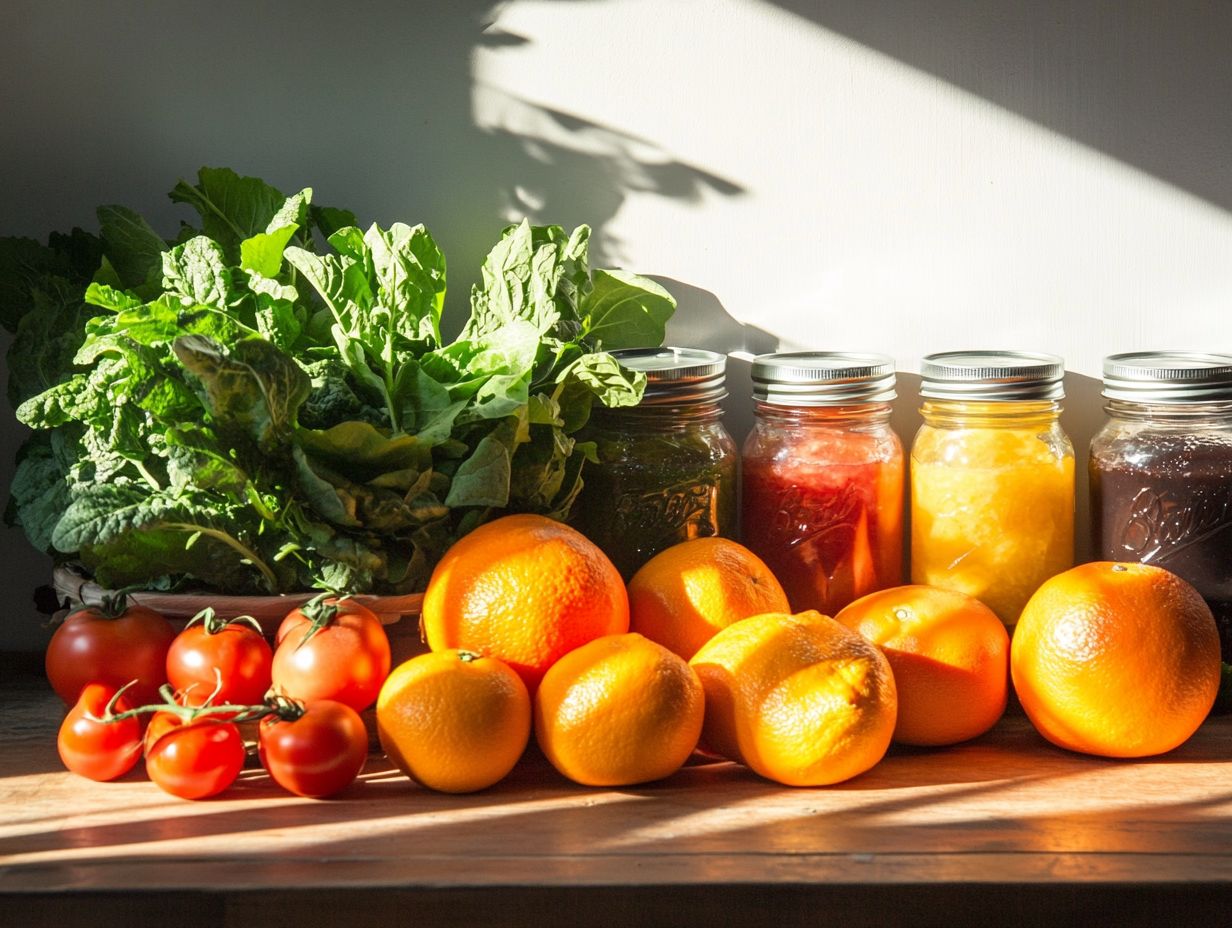How to Adjust Your Meal Plan with Seasonal Changes
Seasonal eating is more than just a trend. It is a lifestyle choice that connects you with the natural rhythms of the world around you.
By synchronizing your diet with the seasons, you can savor fresher, more flavorful foods. You also unlock a multitude of nutritional and environmental advantages.
This article explores the essence of seasonal eating. We offer insights on how to effortlessly incorporate seasonal ingredients into your meal planning while addressing common challenges you may face.
Adjusting your food choices can significantly enhance your health and promote sustainable practices. Discover the joys of seasonal eating!
Contents
- Key Takeaways:
- Understanding Seasonal Eating
- Benefits of Adjusting Your Meal Plan with Seasonal Changes
- How to Incorporate Seasonal Foods into Your Diet
- Adapting to Seasonal Changes in Your Food Choices
- Challenges and Solutions for Seasonal Eating
- Frequently Asked Questions
- 1. How can I adjust my meal plan with seasonal changes?
- 2. Should I drastically change my meal plan each season?
- 3. How do I know what foods are in season?
- 4. Can I still stick to my dietary restrictions while adjusting my meal plan for seasonal changes?
- 5. How can I make sure I am getting enough nutrients in my meals during seasonal changes?
- 6. What are some tips for meal planning during seasonal changes?
Key Takeaways:

- Seasonal foods not only taste better but also are better for the planet.
- Meal planning and being open to trying new foods are essential for adapting to seasonal changes.
- Overcoming budget constraints and taste preferences can be challenging, but creative solutions, such as buying in bulk and experimenting with new recipes, can make seasonal eating enjoyable.
Understanding Seasonal Eating
Understanding seasonal eating means recognizing the importance of incorporating seasonal ingredients into your culinary repertoire. These ingredients elevate the flavors of your meals and deliver a treasure trove of nutritional benefits.
By embracing seasonal meal planning, you simplify dinnertime, reduce decision fatigue, and gain access to a diverse range of healthy options that cater to your family’s tastes while promoting environmental sustainability.
From the vibrant produce of summer to the hearty root vegetables of winter, seasonal eating invites you to savor fresh flavors year-round.
What is Seasonal Eating?
Seasonal eating means indulging in foods harvested at their peak. This ensures the utmost freshness and flavor.
By aligning your meal planning with nature s cycles, you can enjoy a variety of ingredients that not only taste exceptional but also support farming that protects the environment.
Picture this: spring brings crisp, bright green asparagus and sweet, tender peas, perfect for light, vibrant salads. Then summer arrives with its treasure trove of tomatoes and berries, just waiting to be transformed into refreshing salsas and delightful desserts.
As autumn settles in, root vegetables like carrots and pumpkins take center stage, offering hearty choices for those comforting meals. When winter arrives, greens like kale and Brussels sprouts become versatile ingredients for stews and casseroles that warm the soul.
By embracing these seasonal ingredients, you reduce your reliance on out-of-season produce. This elevates the nutritional value of your meals and cultivates a deeper connection to your local environment.
Benefits of Adjusting Your Meal Plan with Seasonal Changes
Adjusting your meal plan to align with seasonal changes offers a wealth of benefits. You’ll enjoy enhanced nutritional value, superior taste, and the added bonus of environmental sustainability, all of which can be achieved by learning how to revamp your meal plan monthly, transforming family dinners into more enjoyable and meaningful experiences.
Nutritional Benefits
The nutritional benefits of seasonal ingredients are remarkable. They typically have higher nutrient levels than out-of-season counterparts, presenting a fantastic opportunity to elevate your diet.
Take summer’s vibrant fruits, for example berries and peaches are not just a treat for the taste buds; they are packed with antioxidants and vitamins that support heart health and boost immunity.
Conversely, consider winter’s hearty root vegetables like carrots and sweet potatoes. These gems are rich in essential nutrients such as fiber and beta-carotene, vital for digestion and eye health.
By adopting a meal planning strategy that highlights these seasonal staples, you ensure a diverse range of nutrients throughout the year while savoring the unique flavors that each season brings. For more tailored options, consider learning how to customize your meal plan. This intentional approach to meal preparation fosters healthier eating habits and supports local agriculture.
Environmental Benefits

Embracing seasonal meal planning not only enhances your health but also positively impacts the environment by minimizing the need for long-distance food transportation.
This practice encourages you to shop locally, enabling you to purchase fresh ingredients at their peak flavor and nutritional value. By prioritizing seasonal items available at nearby grocery stores, you can significantly reduce the carbon emissions linked to food transport. Choosing these ingredients often proves to be a budget-friendly option, as seasonal produce is typically more affordable due to its abundance.
This harmonious relationship between cost-effectiveness and sustainability enables you to engage in efficient meal prep, transforming how you nourish yourself while contributing to a healthier planet.
How to Incorporate Seasonal Foods into Your Diet
Incorporating seasonal foods into your diet can be effortlessly refined with strategic meal planning tips that emphasize the use of fresh, seasonal ingredients and diverse cooking techniques. By embracing these methods, you elevate not just the quality of your meals, but also your overall dining experience.
Tips for Meal Planning
Effective meal planning requires a structured approach that can significantly alleviate decision fatigue and streamline your grocery shopping for seasonal ingredients.
By crafting a personalized meal planning formula, you can curate a week s worth of meals that showcase the freshest produce available. This not only optimizes your nutrition but also minimizes food waste. Organizing your grocery shopping lists around these planned meals will make your market trips more efficient, ensuring you collect everything you need without those tempting, unnecessary purchases.
Allocating specific time blocks for meal prep can transform cooking into a more enjoyable, unhurried experience, allowing you to embrace seasonal flavors and cultivate a deeper appreciation for the art of cooking.
Adapting to Seasonal Changes in Your Food Choices
Adapting to seasonal changes in your food choices invites you to rethink your meal planning approach and make your meal plans flexible to fully embrace the vibrant flavors each season offers.
This journey not only enriches your culinary repertoire but also allows you to incorporate your family s favorite meals in delightful, seasonal ways.
How to Make the Most of Seasonal Produce
To truly embrace the bounty of seasonal produce, tap into your kitchen creativity by exploring an array of meal ideas that elevate these fresh ingredients.
From the vibrant summer tomatoes to the hearty autumn squash, the possibilities are plentiful throughout the year. If you’re in the mood for Italian cuisine, consider crafting a rustic ratatouille that celebrates late summer vegetables like zucchini and eggplant, beautifully simmered with aromatic herbs and a drizzle of olive oil.
For a BBQ twist, think about marinating asparagus and bell peppers in a zesty lemon-garlic sauce before sending them onto the grill for that perfect char. Asian-inspired dishes like stir-fried bok choy with ginger and garlic can effortlessly transform simple greens into a delightful side dish.
By experimenting with these ingredients, you not only enhance your meals but also add a creative flair that is bound to impress family and friends.
Challenges and Solutions for Seasonal Eating

While embracing seasonal eating presents numerous advantages, it also brings forth challenges like limited ingredient availability and the need to navigate entrenched taste preferences.
However, with a bit of creativity and resourcefulness, practical solutions are readily at hand.
Dealing with Limited Availability and Budget Constraints
Handling the challenges of limited seasonal ingredients and budget constraints can be managed well through strategic grocery shopping and thoughtful meal planning.
By tapping into local farmers markets and grocery stores that showcase seasonal produce, discover affordable options that not only delight your palate but also bolster the community. Planning your meals around these ingredients sparks creativity and presents opportunities to save, especially when items are on sale. Keep an eye out for bulk discounts buying in larger amounts to save money or promotions that spotlight seasonal fruits and vegetables.
Embracing recipes that make full use of ingredients like pairing beet greens with beets can significantly minimize food waste while enhancing both flavor and variety in your diet.
Overcoming Taste Preferences and Habits
Overcoming deep-rooted taste preferences and habits when introducing seasonal produce can be quite a task, but with a dash of creativity in your meal ideas, the transition can become smoother.
Weave those beloved flavors into innovative dishes to elevate the dining experience for your family. Imagine transforming traditional favorites like pasta or tacos by incorporating fresh vegetables creatively. For instance, spiralize zucchini into a fun and healthier pasta alternative, while roasted seasonal bell peppers infuse a delightful sweetness into taco fillings.
Don t shy away from experimenting with different cooking methods grilling, saut ing, or even blending these ingredients into smoothies can significantly enhance their appeal. Involve every family member in the cooking process to foster excitement and encourage them to embrace these new, vibrant flavors.
Frequently Asked Questions
1. How can I adjust my meal plan with seasonal changes?
One way to adjust your meal plan with seasonal changes is to focus on incorporating more seasonal fruits and vegetables into your meals. For guidance on this, check out how to create a seasonal meal plan. This will add variety and flavor, and provide you with the freshest and most nutrient-dense options.
2. Should I drastically change my meal plan each season?

No, you don’t have to make drastic changes to your meal plan every season. Instead, try making small adjustments such as swapping out certain ingredients or exploring how to meal plan using seasonal ingredients that incorporate seasonal foods.
3. How do I know what foods are in season?
One easy way to determine what foods are in season is to visit your local farmers’ market. You can also do some research online or check the produce section of your grocery store for seasonal labels.
4. Can I still stick to my dietary restrictions while adjusting my meal plan for seasonal changes?
Yes, you can still stick to your dietary restrictions while adjusting your meal plan with seasonal changes. Look for seasonal foods that fit within your restrictions and get creative with new recipes that work for your specific dietary needs.
5. How can I make sure I am getting enough nutrients in my meals during seasonal changes?
To ensure you are getting enough nutrients, focus on incorporating a variety of colorful fruits and vegetables into your meals. Different colored produce contain different vitamins and minerals, so incorporating a variety provides a well-rounded nutrient intake.
6. What are some tips for meal planning during seasonal changes?
- Plan ahead and make a grocery list based on seasonal foods.
- Try new recipes that incorporate seasonal ingredients.
- Use frozen or canned seasonal produce when fresh options are not available.
Don t miss out on the delicious seasonal produce available! Share your favorite seasonal recipes or experiences in the comments to create engagement.






